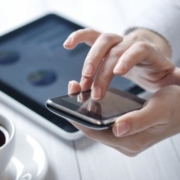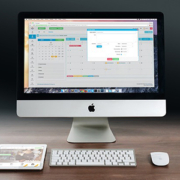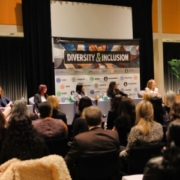Life Hacks: Apps to Make your Life Easier for the busy professional woman
 Today there are applications (apps) for nearly everything imaginable: apps for work; apps to inspire, organize and motivate, and apps to simply waste time.
Today there are applications (apps) for nearly everything imaginable: apps for work; apps to inspire, organize and motivate, and apps to simply waste time.
Today is also a time where the demands on our time are greater than ever. So how do we make the apps work for us as professional women, to give us that extra time we all seem to need at work and at home? Can apps be the key to the work-life balance issue? Are there career opportunities for women to develop more apps based on their own needs?
The Glass Hammer spoke with Marion Regnier, a director in the Financial Services Technology Consulting group at PwC – and avid app user – to provide some perspective on mobile computing and how professional women might use it to manage their busy lives.
The Rapid Proliferation of Mobile Computing – and too many Apps to Choose
In just six years, apps have grown from curiosity to behemoth. In April, Flurry Analytics released its study on mobile computing noting that time spent on a mobile device by the average U.S. consumer has risen to 2 hours and 42 minutes per day from 2 hours and 38 minutes per day in March of 2013. The study states that the data tells a clear story that apps, which were considered a mere fad a few years ago, are completely here to stay.
As the app market has expanded, PwC’s Regnier has become much more selective about the types of apps she installs. “I used to be an early adopter. And I still read reviews on TechCrunch, but now before I download an app, I assess my need for it.”
Where are the most common areas we want to find a little more time and a lot less stress?
The Big Buckets for Mobile Apps – Financial, Travel and Entertainment
While mobile computing has not reached the day where we can print cash at home, it still offers opportunities for immense time saving and convenience. Banking customers now have the ability to do almost any type of transaction from checking balances, making payments, transferring funds to depositing checks, from a mobile app. According to Regnier, banks have worked to make their apps as secure as possible while also remaining convenient for the user. Restrictions on the size of mobile app deposits and daily limits on transfers are likely to remain for now but for professional women who tend to pay with their phones instead of cash, mobile apps in banking have almost entirely replaced the need to go to an ATM or wait in line for a bank teller.
Regnier is watching the roll-out of centralized payment services, like the recently-announced Apple Pay, to see whether the new, more highly-encrypted technologies will win over both vendors (such as banks and stores) as well as users. “The biggest problem with centralized payment apps is that while they create a single point of convenience, they also create a single point for potential failure.”
Assessing your needs properly can help in picking the right app. At one point, Regnier had “a bunch” of budgeting apps on her phone and while she liked them, they ultimately sat unused, “I didn’t have a big need for them.”
The problem was that while it was interesting to watch where she was spending her money, “it was a lot of work to remember to enter each transaction.” Being aware of the downsides of apps is also important. A lot of financial apps enable a user to link bank accounts and credit cards, but in this case, Regnier urges caution, “The more personal information you disclose, the more that information is at risk.”
Mobile Apps Make Things Easier on The Road and Closer to Home
As a PwC consultant, Regnier spends an average of four days a week on the road, so travel apps make up a big part of her arsenal. Depending on the carrier, passengers can book flights, check-in, get electronic boarding passes and rebook when something goes awry. She is a big fan of Delta’s mobile app, “When my flight gets cancelled or I am going to miss a connection, the app rebooks me automatically and lets me know all the new information I need. No more standing on customer service lines or waiting on hold for a phone agent – alongside 200 other stranded travelers.” She also recommends SeatGuru for avoiding undesirable airline seats, something that might not save time but will make the time that much more enjoyable.
On the ground, Regnier has found ways to cut waiting times and stay informed. Regnier encourages airline passengers to consider Über as an alternative to waiting for a taxi, “A lot of times, the taxi line is really long at the airport and I often find that Über is not that much more expensive and I avoid much of the wait.” She is also a big fan of Waze for crowd-sourced real-time information on traffic and the best available routes. “It’s a big step up from Google maps and you don’t have to rely on the radio for traffic reports, especially in congested New York City!.”
Regnier uses Flipboard to gather travel tips on places both near and far from home. “It’s like a personal magazine. It curates information for the user including feeds from facebook, twitter and other sources. I find it nice for getting tips from travel blogs I might not ordinarily run across.” She also uses OpenTable to easily make meal reservations and Seamless to order in, perfect for scheduling a business meal or coordinating food to arrive while working late.
Using Mobile Apps to Manage the Information Flow and Entertainment
Gaming and messaging/social networking still make up the lion’s share of mobile computing use according to the study by Flurry Analytics. Mobile users spend only 11% of their time on news and entertainment (including youtube), and this is an area where Regnier sees a lot of opportunity for new and better apps. “I get a lot of my info from NPR (National Public Radio), newspapers and a range of sites. Flipboard is good for written content, but it can get cumbersome if I have to put in subscriber information for a lot of paid sites.”
Looking out, she expects to see apps aimed at consolidating our information and entertainment – perhaps a next generation version of Netflix or Amazon Streaming – an app that works well with video and audio, consolidates one’s entertainment content into an easy to use app and that curates or suggests new content from a range of sources. Allowing even our downtime to become more streamlined.
What about Apps for Daily Chores?
Notably absent from our discussion were the plethora of apps designed to help with daily chores such as Shyp, TaskRabbit and Blue Apron. In a city like New York, particularly if you are fortunate to live in a building with a full-time staff, convenience services such as delivery of nearly anything anytime and many repairs are almost a given.
Regnier, who calls New York home when she’s not traveling, notes, “Indeed there is an increase of “chore” and “to-dos” apps that are meant to create a solution for the never-ending quest of saving time and reallocating it for something more rewarding or useful to us. My perspective is that as much as they seem ‘convenient,’ I don’t really see myself becoming a heavy user of these apps. They tend to try to carve out a market within a range of services that already exist… and are of higher reliability and quality. When you can ask your dry cleaner to deliver your dry cleaning, have the post office deliver an empty box to your house, online order your dinner from a nearby restaurant, etc. where is the real need for chore apps?”
Regnier sees chore apps as part of the, “There must be an app for that!” trend noting that “creating the solution doesn’t always mean that demand will follow. Also, they tend to focus on large metro areas as compared to the majority of the country, so scaling may become an issue fairly quickly.”
But when asked what sort of app is on the top of her wish list, Regnier responded with an app that is on many busy professionals’ wish list, “An app that knows what’s in my fridge and can tell me what I need at the store!”
By Beth Senko











